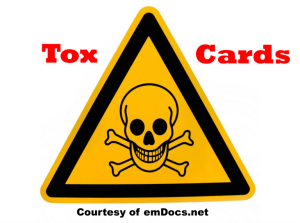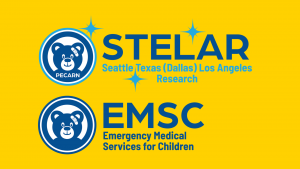Authors: Andrew Pugh, MD (Emergency Medicine Resident, University of Utah Hospitals, Salt Lake City, Utah) and Rob Bryant MD (@RobJBryant13, Emergency Medicine, Utah Emergency Physicians, Intermountain Medical Center, Salt Lake City, Utah) // Edited by: Alex Koyfman, MD (@EMHighAK) and Brit Long, MD (@long_brit)
No good sentence ever starts with ‘remember that trauma patient’. Missed injuries are the bane of the emergency physician’s existence. There are some key risk factors to be aware of and gaps in our practices to overcome that will allow us to reduce the incidence of missed injuries in trauma patients.
Consider this case example:
A 32-year-old male presents via EMS after being hit by a car while walking across a road at 0100. EMS pre-arrival report states that he is intoxicated, combative on scene, and has signs of serious head injury – they have splinted an open right lower extremity fracture and have given 150 micrograms of Fentanyl for pain.
On initial evaluation the patient is unresponsive. He has multiple facial lacerations and a large temporal hematoma. You note reduced left sided breath sounds and a thready left radial pulse. Secondary survey demonstrates flail chest, closed left forearm fracture, and open right tibial fracture. Vitals signs include BP 90/63, HR 123, RR 25, and SpO2 92% on non-rebreather at 15L.
The patient is emergently intubated, large bore IV access is established bilaterally, and massive transfusion protocol is initiated and delivered by a rapid transfusion device. He gets a left sided surgical chest tube, pelvic binder, antibiotics, and tetanus booster prior to CT scan. After intubation you reduce and splint his left wrist fracture in the trauma bay.
On day 3 of his hospital stay, he is stepped down from ICU to trauma floor. He has significant ongoing swelling of his left upper extremity with severe pain. He has reduced sensation distally and not moving his left arm. With further imaging you identify a left elbow dislocation; he is taken to the OR for emergent reduction.
This patient presents with a serious mechanism of injury and evidence of multi-system trauma. He has multiple risk factors for a missed injury. It is imperative that the Emergency Physician recognizes this and is vigilant in order to prevent serious sequelae. In this case, despite lifesaving emergent trauma care and resuscitation, an elbow dislocation goes unrecognized for 3 days; this may have serious implications for the patient down the road. This post will focus on the importance of missed injuries in trauma patients, risk factors for missed injuries, and will detail an approach to reduce the incidence.
Definition
‘Missed injury’ is a term found ubiquitously in the trauma literature. Established definitions vary relating to the time of identification and the clinical significance of the injury. The definition that is most applicable to our practice in the Emergency Department is ‘an injury identified after the initial phase of trauma resuscitation’(aka the primary and secondary survey) (1).
Importance
Missed injuries are important because they convey morbidity and mortality for patients (2). Failing to consider and identify blunt cervical vascular injury in an obtunded patient may lead to stroke, permanent neurological deficits, and disability. Failing to recognize elbow dislocation in a multi-system trauma patient, although seemingly trivial during the initial resuscitation stage, can ultimately lead to chronic pain, disability, and affect the patient’s ability to work which has both personal and societal burden. Ultimately, missed injuries have the potential to exacerbate the severity of the initial trauma insult. Missed injuries can result in permanent disability or even mortality and add significantly to the length of hospitalization and overall costs of patient care (2).
Epidemiology
Published missed injury rates vary from 1.9–39%; up to 22 % of these are clinically significant (3). The true incidence of missed injuries is extremely difficult to calculate. The literature is hampered by a lack of standard definitions, variable injury severity scores between study patients, and a paucity of prospective data (we know that retrospective studies tend to underestimate the missed injury rate).
Analysis of a large trauma registry out of LA County provides an insight into preventable missed injury types (4). Over an 8 year period, they had 58 missed injuries that they classified as preventable. The most common missed injury was hollow viscus injury affecting 15 patients. They report 9 missed solid organ injuries, 9 fractures, 7 vascular injuries, and 5 diaphragmatic injuries. They report 2 missed peripheral nerve injuries, 2 missed intracranial injuries, and 6 injuries classified under the category of other (ureter, soft tissue, chest).
Risk Factors
Injury Severity
The biggest risk factor for missed injury is the patient with multiple, severe injuries. This can be calculated with the injury severity score (ISS), though this isn’t always easy to calculate at the bedside. The key is to consider that the more injuries you find on initial examination, the greater risk you miss another injury. Patients experiencing polytraumatic injury and patients with head injury, altered mental status, or requiring intubation are at high risk of missed injury (5,6).
Mechanism
Mechanism of injury is strongly associated with the incidence of missed injury. Auto vs pedestrian, auto vs bicycle, motor vehicle accident, and fall from a height are mechanisms associated with a higher missed injury rate (7), most likely as a result of the fact they are associated with increased injury severity burden.
Distracting Injury
The pain response can be affected after a major injury, and patients may not process pain from all injury sites equally (2).
Administration of Analgesia and Sedation
The effect of analgesia administration on missed injury rate is unclear.Analgesia is an integral part of trauma patient management and should not be withheld for fear of masking an injury.Sedation likely plays a more significant role in missed injuries than analgesia. Unless specifically indicated (severe agitation or intubation), sedatives should be rarely used in the setting of acute traumatic injury (2).
Time of presentation
A large retrospective study out of Perth, Australia demonstrated a correlation between trauma presentation at night (as opposed to standard ‘office hours’) and missed injury rate. This is likely a product of increasingly severe injuries seen at night, and the presence of less senior staff coverage [normal for medical training environment in Commonwealth countries] which is known to be a risk factor for missed injury in itself (8).
Human Factors
In a study from a large trauma center in South Africa, the authors identified that 41% of missed injuries were due to inadequate clinical assessment, while 32% were due to errors related to imaging (wrong investigation or misinterpretation), thus implying that a significant proportion of injuries are due to human error. Human error culminating in adverse patient safety is something we should seek to mitigate at all costs and is a topic of much research focus (3). Also be aware of the things that make us underperform on shift: HALT (Hungry, Angry, Late, Tired) and acknowledge when those factors are present in the resus room.
Prevention
Have high suspicion in those with high injury severity score and reduced GCS
Prevention begins with recognizing who is at risk. We must have a high suspicion and a special focus on unconscious and intubated patients with severe trauma (multiple injuries or ISS↑) and brain injuries (GCS↓) during the primary and secondary survey (1).
Consider what injuries you might expect based on the mechanism
An important diagnostic adjunct in reducing the frequency of missed injuries is active consideration of the mechanism of injury. Understanding the constellation of injuries that are frequently seen with specific mechanisms may improve the chance of identifying all potential injuries. For example, Waddell’s triad is an injury pattern that is expected in auto vs pedestrian accidents. It describes the constellation of lower extremity fractures from the impact with the vehicle’s bumper, closed head injury from collision with the windshield, and torso and spine injuries from the patient being thrown onto the roadway (as seen in our case at the start of this post). Understanding how mechanism affects injury pattern allows you to predict certain injuries and therefore actively seek them in the trauma bay (1, 2).
Trust your exam and gestalt
It is important to trust your exam and not rely solely on imaging. We, as the initial Emergency provider, have the insight and advantage of seeing the patient at presentation, taking EMS report and examining the patient. The advent of the ‘trauma-gram’ has no doubt reduced the missed injury rate. However, CT scan in itself, and the initial radiologist’s read of that CT scan, is not infallible. A study of 2354 consecutive whole body CT scans in patients with multiple traumas demonstrated a 12.9% missed injury rate on the initial ‘hot read’; 2.5 % of these injuries were clinically significant (9). Rely on your exam and your gestalt – selective observation of patients with concerning mechanisms and examinations is an accepted management strategy and is often in the best interests of the patient, even in the face of initial negative imaging.
Keep an awareness of overall context (meds, distracting injury)
Having an awareness of context is critical; knowing that your patient has had 150 micrograms of Fentanyl as well as a distracting injury should heighten your concern for occult injuries and lower your threshold for further imaging, observation, and admission. A lower threshold for further testing is recommended in patients who cannot provide a reliable history or exam.
Adequate patient exposure is vital; examine head to toe
The importance of adequately exposing the patient in the trauma bay cannot be over emphasized. We cannot diagnose what we cannot see. Potentially catastrophic injuries are easy to miss if we inadequately expose. Examples include penetrating perineal wounds and blood at the urethral meatus suggestive of urethral or bladder injury. Ensure the patient is kept warm with warmed blankets, but ensure you examine head to toe and leave no body part unexamined.
Complete your assessment
Ensure you complete your assessment in full. Whether you follow an ABCDE approach, MARCH, or a local trauma algorithm, complete it in its entirety. In the heat of a trauma resuscitation, it is easy to become derailed. Keep coming back to your algorithm. It is there to provide a systematic approach for moments such as these and will minimize the risk of missing something.
Acknowledge Human Factors / Biases
Be aware of your weaknesses’ and biases, actively acknowledge their presence, and correct them wherever possible.
Take home messages
- Missed injuries in trauma patients have potentially devastating consequences. Avoidance begins in the ED upon initial assessment.
- As Emergency Physicians we should recognize who is at risk and focus on identifying all injuries.
- Sometimes we have concern based on our examination despite negative imaging; in these patients we should have a low threshold for observation or admission.
- Prevention techniques include consideration of mechanism, taking a step back and considering overall context (presence of analgesia or sedation, intoxication or distracting injury), and adequate patient exposure.
References/Further Reading
- Pfeifer, R et al. Missed injuries in trauma, a literature review. Patient Saf Surgery. 2008. 2:20
- Stawicki SP and Lindsey DE. Missed traumatic injuries, a synopsis. IJAM. 2017. 3(3): 13-23
- Clarke DL et al. Applying modern error theory to the problem of missed injuries in trauma. World J of Surgery. 2008. 32(6): 1176-82.
- Teixeira PGR et al. Preventable morbidity at a mature trauma center. Arch Surgery. 2009. 144(6): 536 – 542.
- Buduhan G, McRitchie DI. Missed injuries in patient with multiple trauma. J Trauma 2000. 49: 600-5.
- Houshian S, Larsen MS, Holm C. Missed injuries in a level I trauma center. J Trauma 2002. 52: 715-9.
- Beatty JS et al. Missed Injuries in Pediatric Trauma Patients. Journal of Applied Research. 2009. 9(3).
- Mazahir S et al. Office Hours vs After Hours. Do presentation times affect the rate of missed injury in trauma patients. Injury. 2015. 46(4).
- Banaste, N et al. Whole Body CT in Patients with Multiple Traumas: Factors leading to missed injury. Radiology. 2018. 28.








